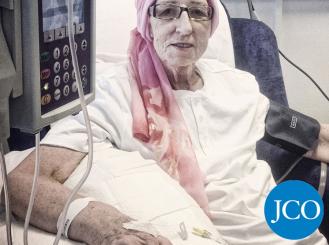Jul 05, 2016
By Shira Klapper, Senior Writer/Editor
Older patients with cancer are at increased risk for toxicity from chemotherapy, and therefore, historically, oncologists have been more cautious in treating this population. However, people age differently, and chronological birth date may not be the strongest indication of a patient’s fitness to tolerate chemotherapy; just think of the 78-year old who outlifts everyone at the gym, and conversely, the 65-year old who is struggling with multiple comorbidities.
This variation in health between older patients has spurred researchers to develop a geriatric assessment for older adults with cancer, a tool that can predict risk of toxicity, not based on age, but on the patient’s physical and mental health status, as indicated by functional status, cognition, nutrition, social support, and other factors.
In a recent study, published in the Journal of Clinical Oncology (JCO), online, ahead of print, May 16, researchers reported that an 11-item tool, including geriatric assessment items, given to 250 patients with cancer, age 65 and older, was able to predict a patient’s risk of chemotherapy toxicity. The study, “Validation of a Prediction Tool for Chemotherapy Toxicity in Older Adults With Cancer,” found that a higher risk score was significantly associated with a higher risk of toxicity. In addition, the study, which was carried out across eight institutions, found that this prediction tool had a greater ability to predict risk compared to the Karnofsky Performance Status (KPS).
These findings validate the findings from a 2011 study published in JCO, carried out by many of the same authors of the current study.
Commenting on these findings, Arti Hurria, MD, the study’s first author, said, “The 2011 paper reported on the development of the predictive model. And once we had those findings and saw that we had a good series of questions to ask, we wanted to then validate the findings in another data set, to see if the results we found the first time around are true. So, we were quite pleased that a separate, independent data set, which followed patients prospectively, also found that these questions could predict who was at risk for chemotherapy toxicity. This study confirms those previous results and gives us confidence about using this predictive model for chemotherapy toxicity in daily practice.”
Eleven variables, including geriatric assessment items, predict chemotherapy toxicity
The geriatric assessment was completed before patients started chemotherapy, and included six baseline characteristics and five questions for the patient to answer. The baseline characteristics included age of patient, cancer type, planned chemotherapy dose, planned number of chemotherapy drugs, hemoglobin, and creatinine clearance. The five geriatric assessment questions addressed the patient’s hearing; number of falls in the past 6 months; whether the patient could take their own medicine; whether the patient’s health limited them in walking one block; and whether, during the past 4 weeks, the patient’s physical or emotional health problems interfered with their social activities.
Geriatric assessment questions help doctors and patients decide on treatment course
The development of a validated predictive tool for chemotherapy toxicity, which includes geriatric assessment questions, is of increasing importance since people 65 years and older account for 60% of cancer cases in the United States. Studies show that older patients who receive chemotherapy derive as much benefit as younger patients—the geriatric assessment that Dr. Hurria and her colleagues developed can help older patients and their doctors decide on the right course of treatment based on the risk of toxicity.
“A geriatric assessment underscores the understanding that aging is a heterogeneous process and that age is only one factor that can identify who will or will not tolerate a certain chemotherapy regimen,” said Dr. Hurria. “The overall goal of this study was to develop a user-friendly tool, incorporating geriatric assessment questions, that can be used in daily practice to understand what an older adult’s risk is for chemotherapy side effects. This information can then be utilized when weighing the risks and benefits of chemotherapy treatment, as well as in guiding rationale interventions to potentially decrease that risk.”
“This predictive tool, which includes geriatric assessment questions, is a relatively easy tool to utilize in daily practice—just eleven questions, five of which you would ask the patient,” continued Dr. Hurria, “and it allow you to share results with the patient and really think about the treatment risks and benefits together, in order to truly personalize the treatment decision.”
Arti Hurria, MD, is Director of the Cancer and Aging Research Program, Co-Leader of the Cancer Control and Population Sciences Program, and Professor of Medical Oncology and Therapeutics Research at City of Hope. An ASCO member since 2001, Dr. Hurria has served on several ASCO committees. She is Leader of the ASCO Geriatric Oncology Special Interest Group, Chair of the Professional Development Committee, Chair-Elect of the Cancer Research Committee, Associate Editor of the Cancer.Net Editorial Board, and a member of the Journal of Clinical Oncology Editorial Board. She has served on the Special Awards Selection Committee, as a Track Leader of the Cancer Education Committee, Chair of the Lifelong Learning Subcommittee, and on the Task Force on ASCO Volunteer Groups. Dr. Hurria is also a previous participant in the Leadership Development Program and recipient of the Conquer Cancer Foundation of ASCO’s Young Investigator Award and Career Development Award.
Abstract of the original JCO article.
PDF of the original JCO article.
Hurria A, Mohile S, Gajra A, et al. Validation of a prediction tool for chemotherapy toxicity in older adults with cancer. J Clin Oncol. Epub 2016 May 16.
The Exclusive Coverage series on ASCO.org highlights selected research from JCO, JOP, and JGO, with additional perspective provided by the lead or corresponding author.
@ 2016 American Society of Clinical Oncology


